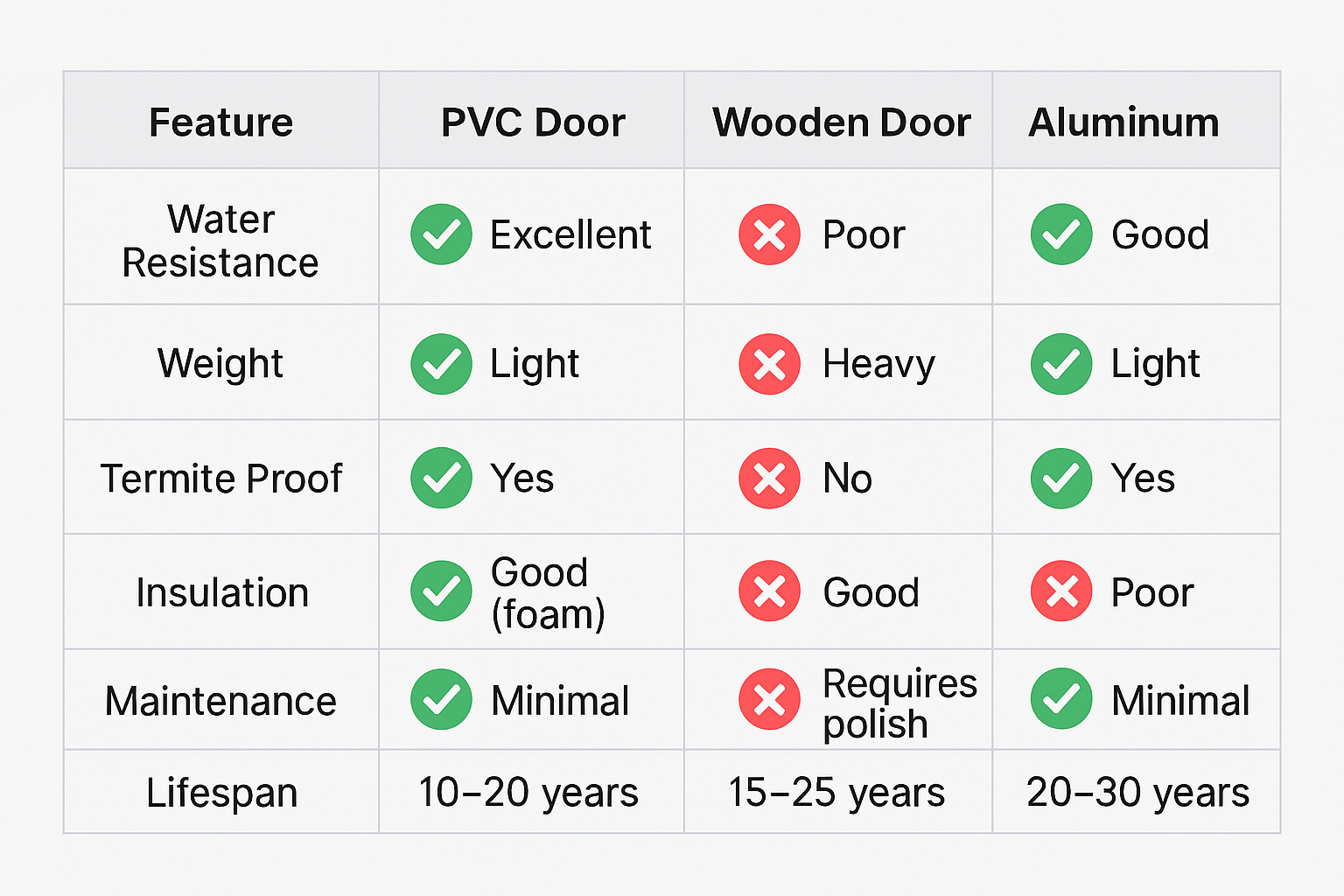PVC doors, or polyvinyl chloride doors, are popular in residential, commercial, and industrial settings for their durability, moisture resistance, and cost-effectiveness. PVC doors are a popular alternative to wooden or metal doors because of their ease of cleaning, variety of designs, and affordability. Whether you are planning a renovation, furnishing a new home, or supplying a construction project, it is important to understand what PVC doors are and why they are suitable for your needs.
1. What is PVC?
PVC stands for Polyvinyl Chloride, a type of synthetic plastic polymer that is widely used in construction materials. When used in doors, it is typically uPVC (unplasticized PVC), which is more rigid, weather-resistant, and ideal for structural use.
2. Structure of a PVC Door
A standard PVC door typically comprises:
Outer PVC Panel: Lightweight, weatherproof surface
Core Material: Can be hollow, honeycomb paper, foam, or filled with composite wood for extra strength
Steel Reinforcements: Sometimes added in higher-end models for structural rigidity
Laminated or Embossed Finish: Wood grain effect, glossy white, or matte options
Visual Table: Common PVC Door Construction
| Component | Material Type | Purpose |
|---|---|---|
| Outer Layer | PVC Sheet | Weather resistance, aesthetics |
| Core | Honeycomb / Foam / Wood | Structure, sound insulation |
| Reinforcement | Galvanized Steel (optional) | Additional strength |
| Surface Finish | Laminate / UV Coating | Appearance, scratch resistance |
3. Key Benefits of PVC Doors
PVC doors are chosen for a variety of practical reasons. These include:
Water Resistance: Ideal for bathrooms, kitchens, and coastal areas
- Durability:PVC is a durable material that resists cracking, chipping, and warping, even under harsh weather conditions.
Termite-Proof: Unlike wood, PVC is not prone to insect damage
Rust-Free: No corrosion as seen in metal doors
Maintenance-Free: Wipe clean, no polishing required
Cost-Effective: Affordable without compromising basic performance, PVC doors are easy to clean and require minimal upkeep, with no need for painting or staining.
Lightweight: Easy to transport and install, PVC doors are relatively lightweight, making them easier to install and handle.
Sound Insulating: Foam-core models offer quiet operation
Recyclable: Environmentally conscious choice
4. Where Are PVC Doors Used?
PVC doors are used in a wide range of applications, including commercial, residential, and industrial settings. They are favored for their durability, resistance to moisture, and energy efficiency. PVC door can be found in:
- Residential Use
Bathrooms
Kitchens
Bedrooms
- Commercial Spaces
Clinics and hospitals (due to hygiene properties)
Small offices
- Institutional Buildings
Schools
Labs and cleanrooms
- Temporary Structures
Porta-cabins
Storage areas
5. Types of PVC Doors
PVC doors are available in various styles, depending on their construction and finish, including folding, sliding, hinged, bathroom door, as well as different types of frames and finishes. They are popular for their durability, weather resistance, and low maintenance requirements. Here are some popular types:
| Type | Description | Best For |
|---|---|---|
| PVC Folding Door | Multiple panels folding on a rail | Compact areas, closets |
| PVC Sliding Door | Horizontal movement along tracks | Balconies, space-saving |
| PVC Bathroom Door | Smaller, moisture-resistant with simple design | Toilets, laundry rooms |
| PVC Laminated Door | Decorative finish with wood or stone textures | Bedrooms, interiors |
| Solid PVC Door | Fully filled, heavy-duty doors | Industrial zones, exteriors |
6. Installation and Maintenance Tips
Installation and maintenance are crucial for ensuring equipment, systems, and structures function properly and last for years. Proper installation involves following manufacturer guidelines, ensuring correct placement, and using the right tools and techniques.
Installation: Most PVC doors come with pre-fitted frames and can be installed with minimal tools. They often use click-lock or screw hinges.
Cleaning: Use a mild detergent or a damp cloth. Avoid abrasive chemicals.
Hardware Compatibility: Ensure door handles and locks are suitable for lightweight doors.
7. Environmental Impact
Modern PVC door is increasingly produced with eco-conscious practices, including:
Low-VOC finishes
Recyclable materials
Energy-efficient core insulation
Look for certifications like RoHS or GreenPro when selecting eco-friendly options.
PVC vs. Other Door Materials

PVC doors offer a practical and versatile solution for various applications, combining durability, ease of maintenance, and aesthetic appeal. Whether you’re outfitting a modern apartment or upgrading a wet-area entry, they stand up well to wear, require minimal upkeep, and come in styles to match any decor.
If you have any further questions or need more information beyond the common queries discussed about PVC Door , feel free to visit our factory at Zhejiang Haibo Door Co., Ltd. or check out our website at haibodoor.com. Our team will be happy to assist you and provide prompt answers to any inquiries you may have.

 English
English русский
русский Français
Français Español
Español bahasa Indonesia
bahasa Indonesia عربى
عربى



